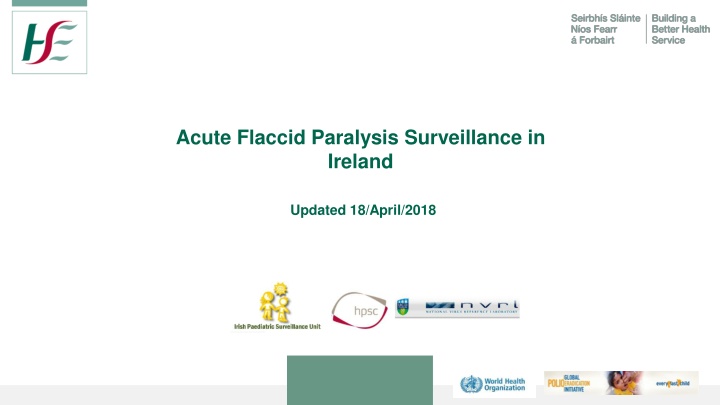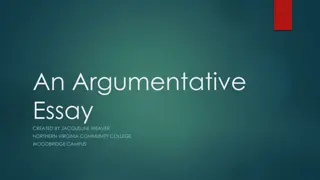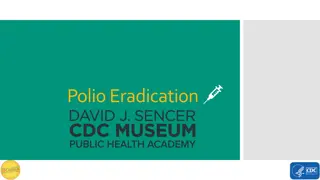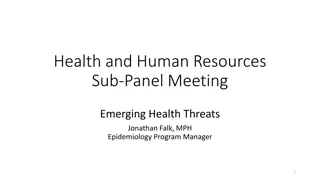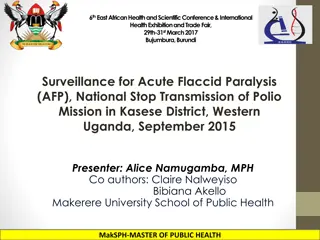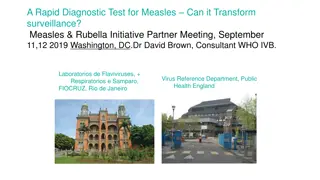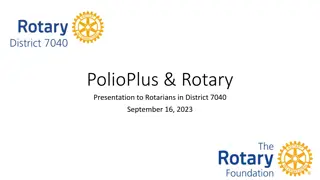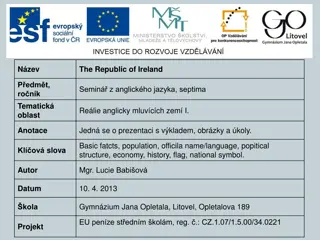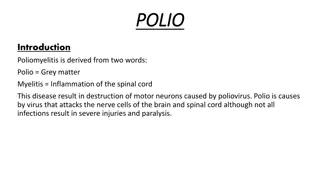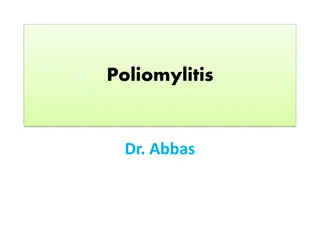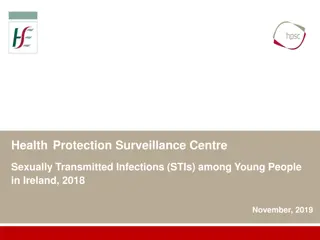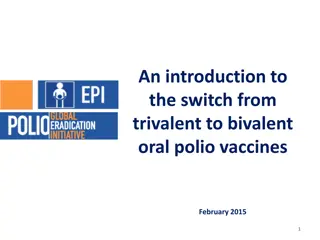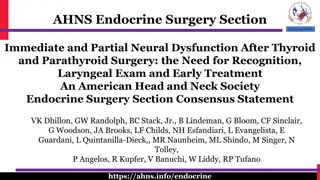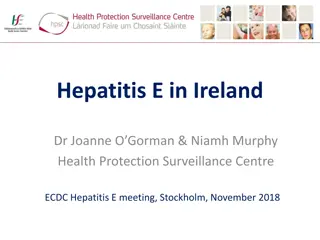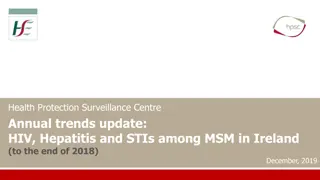Acute Flaccid Paralysis Surveillance in Ireland - Update & Global Polio Eradication Efforts
The Acute Flaccid Paralysis (AFP) Surveillance in Ireland is crucial for monitoring poliomyelitis in the context of global polio elimination initiatives. With no cure for polio, prevention through vaccination is key. The global effort to eradicate polio has seen significant success, with a sharp decline in wild poliovirus cases. However, challenges persist, especially in countries with weakened immunization systems due to conflicts. Continuous surveillance and vigilance are essential to prevent the reemergence of polio.
Download Presentation

Please find below an Image/Link to download the presentation.
The content on the website is provided AS IS for your information and personal use only. It may not be sold, licensed, or shared on other websites without obtaining consent from the author.If you encounter any issues during the download, it is possible that the publisher has removed the file from their server.
You are allowed to download the files provided on this website for personal or commercial use, subject to the condition that they are used lawfully. All files are the property of their respective owners.
The content on the website is provided AS IS for your information and personal use only. It may not be sold, licensed, or shared on other websites without obtaining consent from the author.
E N D
Presentation Transcript
Acute Flaccid Paralysis Surveillance in Ireland Updated 18/April/2018
HSE-HPSC | AFP Surveillance in Ireland AFP surveillance and Polio Surveillance of AFP is used in surveillance for poliomyelitis in the context of the global polio elimination initiative Polio is caused by a human enterovirus called poliovirus. Wild polioviruses (WPV) occur naturally, of which there are three types There is no cure for polio, it can only be prevented; Polio (poliomyelitis) mainly affects children under 5 years of age 1 in 200 infections leads to irreversible paralysis. Among those paralysed, 5% to 10% die when their breathing muscles become immobilized Source: http://www.who.int/en/news-room/fact-sheets/detail/poliomyelitis
HSE-HPSC | AFP Surveillance in Ireland Rationale for AFP surveillance worldwide (i) Polio - one of only a limited number of diseases that can be eradicated as there are no long-term carriers of the disease and an inexpensive vaccine is available Failure to eradicate polio from remaining strongholds could result in as many as 200 000 new cases every year, within 10 years, globally In 1988, the Forty-first World Health Assembly adopted a resolution for the worldwide eradication of polio. It marked the launch of the Global Polio Eradication Initiative (GPEI), spearheaded by national governments, WHO, Rotary International, the US Centers for Disease Control and Prevention (CDC), UNICEF Source: http://www.who.int/en/news-room/fact-sheets/detail/poliomyelitis
HSE-HPSC | AFP Surveillance in Ireland Rationale for AFP surveillance worldwide (ii) Cases die to wild poliovirus have decreased by over 99% since 1988, from an estimated 350 000 cases then, to 22 reported cases in 2017. As a result of the global effort to eradicate the disease, more than 16 million people have been saved from paralysis. Of the 3 strains of wild poliovirus (type 1, type 2, and type 3), wild poliovirus type 2 was eradicated in 1999 and no case of wild poliovirus type 3 has been found since the last reported case in Nigeria in November 2012. The incidence of WPV1 cases in 2017 is the lowest ever recorded. Sources: http://www.who.int/en/news-room/fact-sheets/detail/poliomyelitis; http://www.who.int/news-room/detail/13-02-2018-statement-of-the- sixteenth-ihr-emergency-committee-regarding-the-international-spread-of-poliovirus
HSE-HPSC | AFP Surveillance in Ireland Rationale for AFP surveillance worldwide (iii) Increasing number of countries where immunization systems have been weakened/disrupted by conflict and complex emergencies underlines the potential of serious consequences for further international spread. For example, after >2 years without detection of wild polio in Nigeria, the 3 laboratory confirmed WPV1 cases in children between 2 and 5 years of age with onset between July and August 2016 were confirmed These detected viruses were closely linked to WPV1 last detected in the Nigerian state of Borno in 2011, an indication that this strain had been circulating without detection since that time Sources: http://www.who.int/news-room/detail/13-02-2018-statement-of-the-sixteenth-ihr-emergency-committee-regarding-the-international- spread-of-poliovirus; http://www.who.int/csr/don/06-october-2016-polio-nigeria/en/
HSE-HPSC | AFP Surveillance in Ireland Rationale for AFP surveillance worldwide (iii) In addition to the wild polio cases reported in Nigeria in 2016, a vaccine-derived poliovirus type 2 (cVDPV2) has also been detected in specimens collected from a healthy household contact of one of the WPV1 cases recently reported as part of strengthened disease surveillance activities being implemented in the area. The genetic analysis of the isolated strain indicates that also this cVDPV2 strain has been circulating in the area for at least two years. Source: http://www.who.int/csr/don/06-october-2016-polio-nigeria/en/
HSE-HPSC | AFP Surveillance in Ireland Rationale for AFP surveillance worldwide (iii) Populations in fragile states are vulnerable to outbreaks and are exceedingly difficult to control and threaten the completion of global polio eradication during its end stage. In February 2018 states infected with WPV1, cVDPV1 or cVDPV3 include Afghanistan, Pakistan and Nigeria states infected with cVDPV2s include Democratic Republic of the Congo, Nigeria and Syrian Arab Republic States no longer infected by WPV1 or cVDPV, but which remain vulnerable to re-infection include Cameroon, Central African Republic, Chad and Niger Source: http://www.who.int/news-room/detail/13-02-2018-statement-of-the-sixteenth-ihr-emergency-committee-regarding-the-international-spread- of-poliovirus
HSE-HPSC | AFP Surveillance in Ireland Rationale for AFP surveillance worldwide (iv) In 2015 coverage with 3 doses of polio vaccine was 94% in the European Region and 86% globally. In June 2002, all 53 countries in the WHO European Region were certified polio free: Since certification, more than 90 million infants across the Region have received the recommended 3 doses of polio vaccine. National and regional surveillance systems and laboratories have ensured that no polio case could have been left undetected. A sustained effort of immunization and disease surveillance helps maintain the Region's polio-free status. Source: http://www.euro.who.int/__data/assets/pdf_file/0005/276485/Factsheet-Polio-en.pdf?ua=1; http://www.euro.who.int/en/health- topics/communicable-diseases/poliomyelitis/maintaining-polio-free-status-of-european-region-as-part-of-the-global-polio-endgame-strategy
HSE-HPSC | AFP Surveillance in Ireland Polio Eradication and Endgame Strategic Plan 2013 2018 On 26 May 2012, the World Health Assembly called for the development of a comprehensive strategy to achieve a polio-free world by 2018. The plan lays out four objectives for the eradication of all polio disease, whether caused by wild poliovirus or circulating vaccine-derived poliovirus, and for the use of established structures to deliver other health services in the wake of eradication. to detect and interrupt all poliovirus transmission; to strengthen immunization systems and withdraw oral polio vaccines; to contain poliovirus and certify interruption of transmission; to plan polio's legacy. Source: http://www.euro.who.int/en/health-topics/communicable-diseases/poliomyelitis/maintaining-polio-free-status-of-european-region-as-part- of-the-global-polio-endgame-strategy
HSE-HPSC | AFP Surveillance in Ireland Rationale for AFP surveillance in Ireland AFP in children < 15 years of age is a rare event in Ireland AFP surveillance is used to ensure that if polio virus was the cause for the AFP that we would recognise it quickly so that action could be taken to prevent spread In Ireland most AFP cases are caused by other enteric viruses (other entero- or other viruses) Having an AFP surveillance in place ensures that investigation into this rare condition we can be sure that we do not miss a polio case if it were to occur
HSE-HPSC | AFP Surveillance in Ireland Cases of Polio in Ireland, 1948-2017 500 Number of Cases Notified 400 Polio vaccine, 1957 Last case reported, 1984 300 200 100 0 1948 1950 1952 1954 1956 1958 1960 1962 1964 1966 1968 1970 1972 1974 1976 1978 1980 1982 1984 1986 1988 1990 1992 1994 1996 1998 2000 2002 2004 2006 2008 2010 2012 2014 2016 Year
HSE-HPSC | AFP Surveillance in Ireland Irish surveillance for AFP- methods Acute flaccid paralysis (AFP) in ALL children < 15 years of age Investigation of suspect cases of CNS infection (e.g. meningitis, encephalitis, AFP) of all ages if travel or epi-links to contacts from areas where polio virus circulating
HSE-HPSC | AFP Surveillance in Ireland Definition of AFP Acute flaccid Paralysis (AFP) is a clinical syndrome characterised by rapid onset of weakness, including (less frequently) weakness of respiratory and swallowing, progressing to maximum severity within several days to weeks. AFP is a complex clinical syndrome with a broad array of potential aetiologies.
HSE-HPSC | AFP Surveillance in Ireland Potential aetiologies associated with AFP Includes possible illness due to: Guillian-Barr syndrome Transverse myelitis Traumatic neuritis Viral infections caused by other enteroviruses, toxins and tumours
HSE-HPSC | AFP Surveillance in Ireland Causes of Acute Flaccid Paralysis (AFP1) Worldwide Note: most common causes of AFP in Ireland indicated in red (*)
HSE-HPSC | AFP Surveillance in Ireland Objectives of AFP surveillance To rapidly detect re-importation of poliovirus into polio-free areas To ensure that robust surveillance systems are in place so that if AFP caused by polio virus that it would be identified quickly
HSE-HPSC | AFP Surveillance in Ireland AFP Investigation in aged children < 15 years 1. 2. AFP case admitted to hospital Collect 2 stool specimens as early as possible, 24 hours apart, within 2 weeks of paralysis onset and send to National Virus Reference Laboratory (NVRL) Complete AFP enhanced surveillance form and return to Paula Flanagan, HPSC, 25 27 Middle Gardiner Street, Dublin 1, Tel: 01 876 5300, Fax: 01 856 1299 Surveillance forms available on ward or available at http://www.hpsc.ie/hpsc/A- Z/VaccinePreventable/Polio/AcuteFlaccidParalysisAFP/ When returning your monthly IPSU (Irish Paediatric Surveillance Unit) card indicate if you have seen a case in previous month 3. 4. 5.
HSE-HPSC | AFP Surveillance in Ireland AFP Reporting Poster * photo courtesy CDC
HSE-HPSC | AFP Surveillance in Ireland AFP reports in children < 15 years of age, by year onset paralysis, 2009-2017 Year of Onset of Paralysis Total 2009 6 2010 4 2011 9 2012 6 2013 8 2014 10 2015 5* 2016 7 2017 3* 2009-2017 58 * excludes one where IPSU reported a suspect AFP case but no enhanced surveillance details were available
HSE-HPSC | AFP Surveillance in Ireland AFP cases by Age Group, 2009-2017 Age Group Total 28 0-4 8 5-9 12 10-14 10 Not specified 58* Total * excludes two (in 2015 and 2017) where IPSU reported a suspect AFP case but no enhanced surveillance details were available
HSE-HPSC | AFP Surveillance in Ireland Acknowledgements The HPSC wishes to thank all those who have contributed to polio surveillance: National Virus Reference Laboratory (NVRL) Irish Paediatric Surveillance Unit (IPSU) Paediatricians in Irish hospitals Siobhan O Malley, Nurse, Temple Street Children s Hospital
